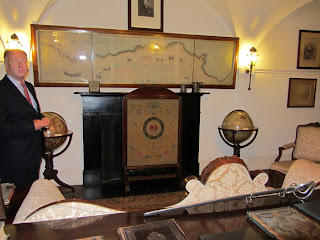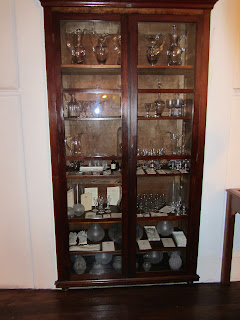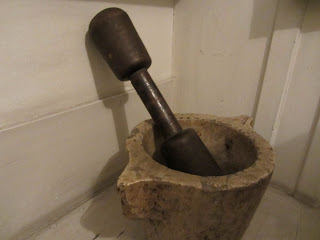According to the literature, in 1827, the British Port shippers formed an association called The Factory House whose express purpose was promoting their interests and defending their priveleges. A structure to house the association was designed and built in the neo-Palladian style (following on the work of the Venetian architect Andrea Palladio 1508-1580) by the British Consul John Whitehead with construction completed in 1790. The Factory House was closed in 1807 when the French invaded Portugal and was reconstituted in 1810 as the British Association, an organization limited to British Port wine shippers. The building was re-opened in 1811 to house the new organization. Today the British Association functions solely as a private club of the Port wine shippers and has 10 male and one (new) female members.
Our transportation the The Factory House was scheduled for 7:15 pm and we were picked up at that time and transported to our destination without incident. We were welcomed outside the building by Paul Symington, CEO Symington Family Estates, and Nick Heath, Marketing Director, Taylor Fladgate and Yeatman. We were ushered into the building foyer where the tour was kicked off with a very warm welcome from these two gentlemen.
According to Paul, The Factory House was built in 1790 and was maintained by merchant contributions which varied in relation to the value of a member's exports. The British Association currently has three sustaining companies.
One of the prized possessions of The Factory House is the first detailed map of the Douro region drawn by Baron Joseph James Forrester 160 years ago. The map shows the river and quintas from San Joao da Foz near the Atlantic coast to Barca d'Alva close to the Spanish border. Baron Forrester was a formidable cartographer and photographer who drowned in the river when his boat hit the rapids and capsized. While alive he had been opposed to fortification of the Douro wine and it is likely that his death eased the way for the advancement of that process. A 21st century edition of the Forrester map by English artist David Eley was introduced to the public in a ceremony held at the Yeatman Hotel on March 3, 2011.
Port shippers were British and sought every opportunity to remind themselves of that fact and to keep as tight a link as possible to the motherland. The practice of all families was to school kids in Portugal up to a certain age and then to send them to England to complete their education and acculturation (a practice that is still followed to this day). The Factory House was a key manifestation of that Britishness. The furnishings and color schemes are reminiscent of a British gentleman's club of yore and, as you walk through the structure, you are transported back to the days when members would congregate here to do business, catch up on the news, read papers of the day, and have lunch. Paul indicated that they had copies of the Times going back over 100 years and on their traditional Wednesday lunches, copies of the paper for that same date 100 years ago are pulled out for members to read. As an aside he mentioned that the same issues we are wrestling with today were being discussed and debated 100 years ago.
Beginning in the 1820s, a library of English books was established at The Factory House to meet the reading needs of the British families living in and around Porto. A fiction library was established initially and books were acquired as published based on librarian perception of need, reader requests, or London book agent initiative. Over the next 70 years the collection grew to over 1000 books. As the number of families declined and reader tastes changed, many of the earliest books were moved to shelves and back rooms to make way for more current material. According to University of Tulsa McFarlane Library, this old fiction library built between 1820 and 1890 lay forgotten until rediscovered in the 1970s. This 2500-volume, 1000-title library now resides at the University of Tulsa. Notwithstanding this fact, The Factory House is still endowed with an extensive library which, according to Paul, is the most valuable item in its inventory. The collection was recently assessed and valued by an English company flown in for that express purpose.
The member's penchant for locking things up and then forgetting about them was once again on display as we were toured through a fully equipped period kitchen. According to Paul, someone had apparently walked out and closed the door to the kitchen and it was forgotten; lost in its own house. But what a gain for us. We were able to see a working kitchen as it functioned rather than the way some curator thought that the pieces might have been arranged.
One can imagine the types of parties that were thrown here based on the splendor of the ballroom and the extensive collection of dance cards on display.
At the conclusion of the tour we were led into a salon for aperitifs and butler-passed hors d'oeuvres. Dinner was a two-room affair with the major courses in the formal dining room and the cheese course in the Port Room.
The menu for the evening's dinner was as follows:
- Course 1: Scallop Tartar with Prawns and Avocado Puree; paired with Symington Family Estates Altano 2010 Douro DOC Branco
- Course 2: Beef Tournedo with Sauteed Potatoes and Vegetables; paired with Symington Family Estates Chryseia 2008 Douro DOC
- Course 3: Trilogy of Traditional Portuguese Puddings with Lemon Sorbet; paired with Taylor's 20 Year Old Tawny
- Cheese Course: Serra and Ilhas Cheese; paired with Graham's 1970 Vintage Port
I sat next to Paul Symington for dinner and thus began three days of intensive education at his hands regarding the history of his family, the land, the business, and his blood. Because all of this is in his blood.




















Excellent information. Thanks for spending the time. Genuinely enjoyed the post.
ReplyDeleteDevon wine tour
Thank you for taking the time to read it and glad that you found it enjoyable. I really enjoyed the experience.
Delete